Comprehensive Analysis of a Singapore Medical School Curriculum Report
VerifiedAdded on 2023/06/03
|8
|2095
|328
Report
AI Summary
This report provides a comprehensive analysis of a medical school curriculum in Singapore, focusing on its objectives, design, and implementation. The curriculum aims to promote professionalism and excellence in medical education, emphasizing generic medicine to prepare students for the evolving healthcare landscape. The analysis explores the curriculum's emphasis on community engagement, empathy, and patient-centered care, highlighting the importance of longitudinal patient experience programs. It also examines contemporary learning theories, including cognitive learning theories, and their impact on learning outcomes and assessment methods. The report discusses various assessment strategies, such as formative and summative assessments, and the role of group assessments in developing critical thinking and collaboration skills. The curriculum's commitment to continuous review and updates, along with the integration of research and a vibrant learning environment, are also discussed. The report concludes by emphasizing the importance of student-teacher relationships, visible learning, and the use of feedback to improve the effectiveness of the curriculum.
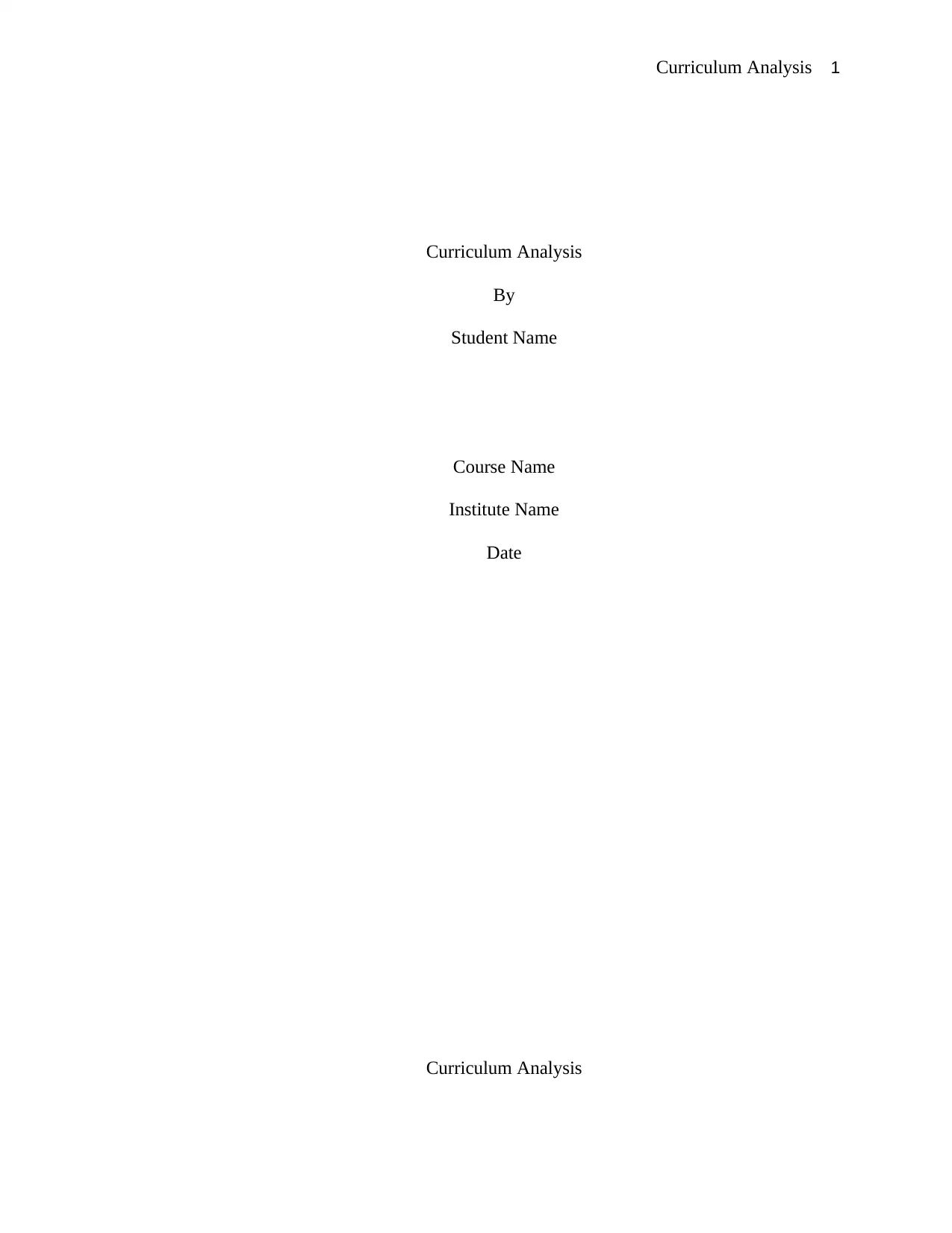
Curriculum Analysis 1
Curriculum Analysis
By
Student Name
Course Name
Institute Name
Date
Curriculum Analysis
Curriculum Analysis
By
Student Name
Course Name
Institute Name
Date
Curriculum Analysis
Paraphrase This Document
Need a fresh take? Get an instant paraphrase of this document with our AI Paraphraser
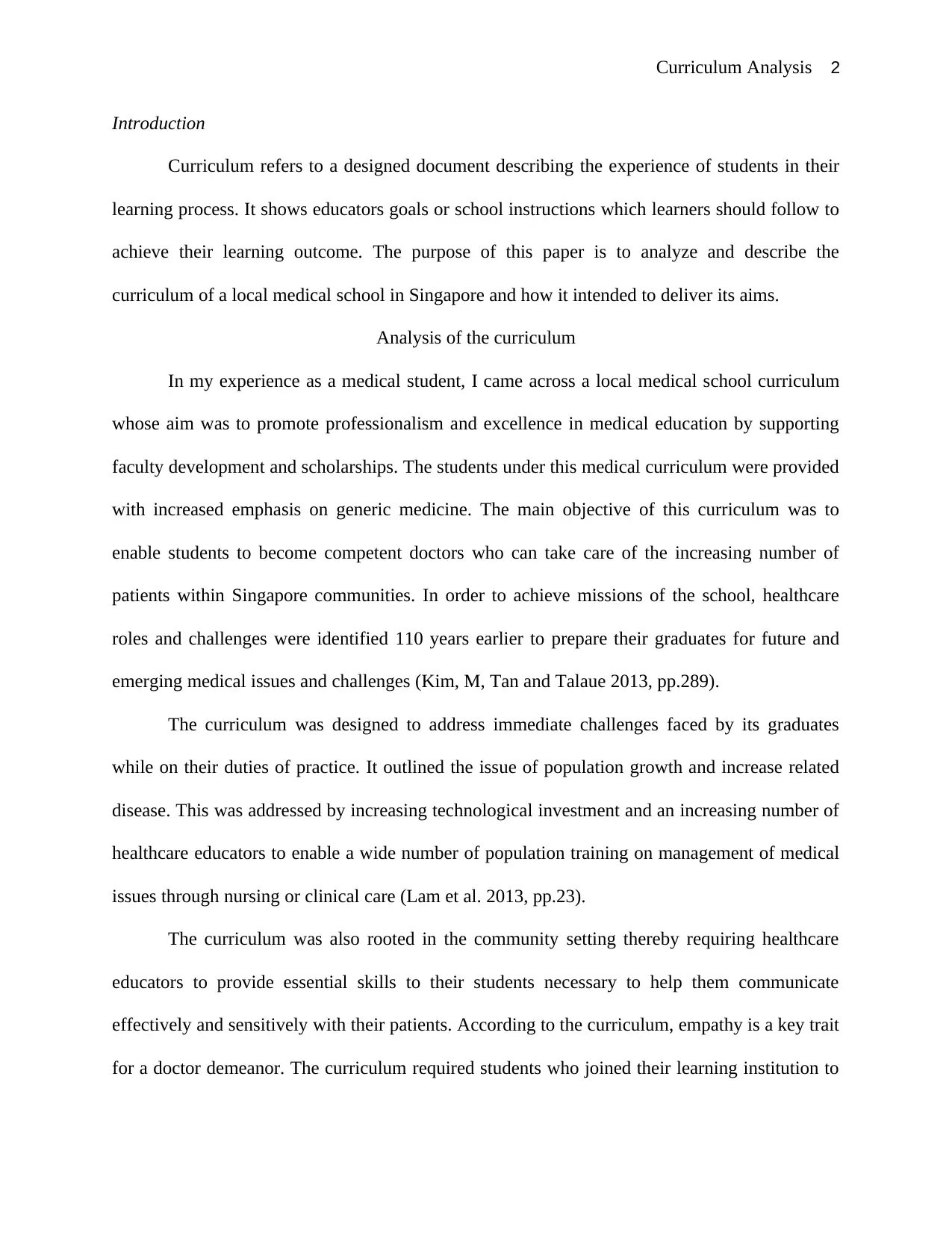
Curriculum Analysis 2
Introduction
Curriculum refers to a designed document describing the experience of students in their
learning process. It shows educators goals or school instructions which learners should follow to
achieve their learning outcome. The purpose of this paper is to analyze and describe the
curriculum of a local medical school in Singapore and how it intended to deliver its aims.
Analysis of the curriculum
In my experience as a medical student, I came across a local medical school curriculum
whose aim was to promote professionalism and excellence in medical education by supporting
faculty development and scholarships. The students under this medical curriculum were provided
with increased emphasis on generic medicine. The main objective of this curriculum was to
enable students to become competent doctors who can take care of the increasing number of
patients within Singapore communities. In order to achieve missions of the school, healthcare
roles and challenges were identified 110 years earlier to prepare their graduates for future and
emerging medical issues and challenges (Kim, M, Tan and Talaue 2013, pp.289).
The curriculum was designed to address immediate challenges faced by its graduates
while on their duties of practice. It outlined the issue of population growth and increase related
disease. This was addressed by increasing technological investment and an increasing number of
healthcare educators to enable a wide number of population training on management of medical
issues through nursing or clinical care (Lam et al. 2013, pp.23).
The curriculum was also rooted in the community setting thereby requiring healthcare
educators to provide essential skills to their students necessary to help them communicate
effectively and sensitively with their patients. According to the curriculum, empathy is a key trait
for a doctor demeanor. The curriculum required students who joined their learning institution to
Introduction
Curriculum refers to a designed document describing the experience of students in their
learning process. It shows educators goals or school instructions which learners should follow to
achieve their learning outcome. The purpose of this paper is to analyze and describe the
curriculum of a local medical school in Singapore and how it intended to deliver its aims.
Analysis of the curriculum
In my experience as a medical student, I came across a local medical school curriculum
whose aim was to promote professionalism and excellence in medical education by supporting
faculty development and scholarships. The students under this medical curriculum were provided
with increased emphasis on generic medicine. The main objective of this curriculum was to
enable students to become competent doctors who can take care of the increasing number of
patients within Singapore communities. In order to achieve missions of the school, healthcare
roles and challenges were identified 110 years earlier to prepare their graduates for future and
emerging medical issues and challenges (Kim, M, Tan and Talaue 2013, pp.289).
The curriculum was designed to address immediate challenges faced by its graduates
while on their duties of practice. It outlined the issue of population growth and increase related
disease. This was addressed by increasing technological investment and an increasing number of
healthcare educators to enable a wide number of population training on management of medical
issues through nursing or clinical care (Lam et al. 2013, pp.23).
The curriculum was also rooted in the community setting thereby requiring healthcare
educators to provide essential skills to their students necessary to help them communicate
effectively and sensitively with their patients. According to the curriculum, empathy is a key trait
for a doctor demeanor. The curriculum required students who joined their learning institution to
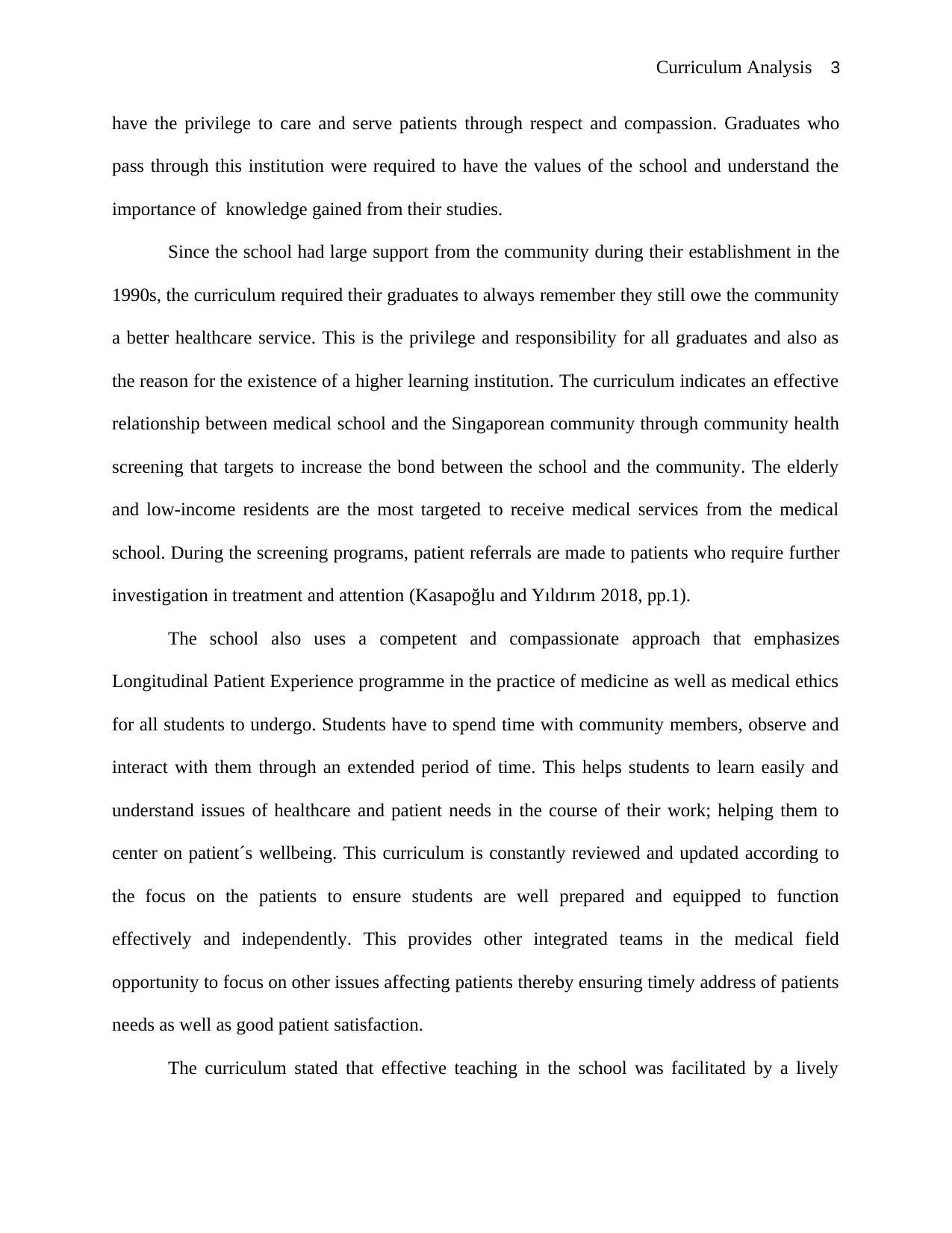
Curriculum Analysis 3
have the privilege to care and serve patients through respect and compassion. Graduates who
pass through this institution were required to have the values of the school and understand the
importance of knowledge gained from their studies.
Since the school had large support from the community during their establishment in the
1990s, the curriculum required their graduates to always remember they still owe the community
a better healthcare service. This is the privilege and responsibility for all graduates and also as
the reason for the existence of a higher learning institution. The curriculum indicates an effective
relationship between medical school and the Singaporean community through community health
screening that targets to increase the bond between the school and the community. The elderly
and low-income residents are the most targeted to receive medical services from the medical
school. During the screening programs, patient referrals are made to patients who require further
investigation in treatment and attention (Kasapoğlu and Yıldırım 2018, pp.1).
The school also uses a competent and compassionate approach that emphasizes
Longitudinal Patient Experience programme in the practice of medicine as well as medical ethics
for all students to undergo. Students have to spend time with community members, observe and
interact with them through an extended period of time. This helps students to learn easily and
understand issues of healthcare and patient needs in the course of their work; helping them to
center on patient´s wellbeing. This curriculum is constantly reviewed and updated according to
the focus on the patients to ensure students are well prepared and equipped to function
effectively and independently. This provides other integrated teams in the medical field
opportunity to focus on other issues affecting patients thereby ensuring timely address of patients
needs as well as good patient satisfaction.
The curriculum stated that effective teaching in the school was facilitated by a lively
have the privilege to care and serve patients through respect and compassion. Graduates who
pass through this institution were required to have the values of the school and understand the
importance of knowledge gained from their studies.
Since the school had large support from the community during their establishment in the
1990s, the curriculum required their graduates to always remember they still owe the community
a better healthcare service. This is the privilege and responsibility for all graduates and also as
the reason for the existence of a higher learning institution. The curriculum indicates an effective
relationship between medical school and the Singaporean community through community health
screening that targets to increase the bond between the school and the community. The elderly
and low-income residents are the most targeted to receive medical services from the medical
school. During the screening programs, patient referrals are made to patients who require further
investigation in treatment and attention (Kasapoğlu and Yıldırım 2018, pp.1).
The school also uses a competent and compassionate approach that emphasizes
Longitudinal Patient Experience programme in the practice of medicine as well as medical ethics
for all students to undergo. Students have to spend time with community members, observe and
interact with them through an extended period of time. This helps students to learn easily and
understand issues of healthcare and patient needs in the course of their work; helping them to
center on patient´s wellbeing. This curriculum is constantly reviewed and updated according to
the focus on the patients to ensure students are well prepared and equipped to function
effectively and independently. This provides other integrated teams in the medical field
opportunity to focus on other issues affecting patients thereby ensuring timely address of patients
needs as well as good patient satisfaction.
The curriculum stated that effective teaching in the school was facilitated by a lively
⊘ This is a preview!⊘
Do you want full access?
Subscribe today to unlock all pages.

Trusted by 1+ million students worldwide

Curriculum Analysis 4
research environment which featured key programs in collaboration with universities in diseases
afflicting population such as diabetes, heart disease, cancer, and dementia. The school comes up
with new approaches and new knowledge on how some diseases are perceived in the community
and their clinical approach based on population health perspectives (Schneider, Barr and Saadeh
2013, pp.1054e)
Quality of education provided by this institution has been recognized by high ranking
which was received from Higher Education World University Rankings. According to the
curriculum,m, the school effort is fulfilled by a combined effort between educators and learners
who help to shape Singapore approach on how medicine is practiced including planning and
delivery of healthcare services to the community members and patients (Bell, Mills and Fadel
2013, p.2)
Contemporary theories of learning
Learning can be defined as a process that a living organism changes its capacity due to
ageing or biological maturation. Learning theories help to create a good understanding of the
level of education and skills within individuals, companies and the nation. It explains the
fundamental importance of learning and primary functions as basic manifestation and abilities of
human life. There are different approaches used for learning today that are compatible with the
global market today. Human learning is influenced by external interaction process between
learner and internal psychological process, cultural or material environment and society (Illeris,
2009).
Cognitive learning theories focus on the internal psychological process. This can be
classified as a modern social learning theory which draws attention from external process alone.
Effective development of persons overall personal functionality is developed through building up
research environment which featured key programs in collaboration with universities in diseases
afflicting population such as diabetes, heart disease, cancer, and dementia. The school comes up
with new approaches and new knowledge on how some diseases are perceived in the community
and their clinical approach based on population health perspectives (Schneider, Barr and Saadeh
2013, pp.1054e)
Quality of education provided by this institution has been recognized by high ranking
which was received from Higher Education World University Rankings. According to the
curriculum,m, the school effort is fulfilled by a combined effort between educators and learners
who help to shape Singapore approach on how medicine is practiced including planning and
delivery of healthcare services to the community members and patients (Bell, Mills and Fadel
2013, p.2)
Contemporary theories of learning
Learning can be defined as a process that a living organism changes its capacity due to
ageing or biological maturation. Learning theories help to create a good understanding of the
level of education and skills within individuals, companies and the nation. It explains the
fundamental importance of learning and primary functions as basic manifestation and abilities of
human life. There are different approaches used for learning today that are compatible with the
global market today. Human learning is influenced by external interaction process between
learner and internal psychological process, cultural or material environment and society (Illeris,
2009).
Cognitive learning theories focus on the internal psychological process. This can be
classified as a modern social learning theory which draws attention from external process alone.
Effective development of persons overall personal functionality is developed through building up
Paraphrase This Document
Need a fresh take? Get an instant paraphrase of this document with our AI Paraphraser

Curriculum Analysis 5
an understanding from things like strategies, methods, way of behaviors, values, attitudes,
meaning, insight and opinion. This help to provide mental energy necessary for learning process
to take place. Learners have a responsibility of constructing meaning be able them to deal with
challenges in practical life. Learning is mostly driven by compulsion or necessity, interest, and
desire which corresponds to how content influences incentives. Good interaction between
educators and learners help in creating and initiating learning process. This is facilitated by
participation, activities, imitations, experience, transmission, and perception. Sometimes learning
may meet barriers; this may include mislearning due to misunderstanding, insufficient prior
learning or lack of concentration (Johnson 2010, pp.E113).
Learning Outcomes and Assessments
Learning outcomes and assessment can be described through the design modules which
are used to come up with the programmes. This helps in viewing education programs in terms of
outcomes and not actions of teachers or curriculum content in the past years. The current
education curriculum presents both programmes that are well established and some that are not
working effectively. There are some programs which describe learning in extreme until they
become unfuctional or deleterious to higher learning. This is because they only address learning
in terms of surface and factual approaches to learning. Assessments on learning outcomes can be
achieved through assessment criteria, linking of levels and learning outcomes as an appropriate
method to determine the work of teaching. This helps to identify areas that need improvement to
promote effective learning and delivering the best skills and knowledge to learners (McClellan
2016, pp.5).
Assessment of students is fundamental for educators to analyze if they are understanding
content provided to them. This is an educative process and significant part of lecturers as an
an understanding from things like strategies, methods, way of behaviors, values, attitudes,
meaning, insight and opinion. This help to provide mental energy necessary for learning process
to take place. Learners have a responsibility of constructing meaning be able them to deal with
challenges in practical life. Learning is mostly driven by compulsion or necessity, interest, and
desire which corresponds to how content influences incentives. Good interaction between
educators and learners help in creating and initiating learning process. This is facilitated by
participation, activities, imitations, experience, transmission, and perception. Sometimes learning
may meet barriers; this may include mislearning due to misunderstanding, insufficient prior
learning or lack of concentration (Johnson 2010, pp.E113).
Learning Outcomes and Assessments
Learning outcomes and assessment can be described through the design modules which
are used to come up with the programmes. This helps in viewing education programs in terms of
outcomes and not actions of teachers or curriculum content in the past years. The current
education curriculum presents both programmes that are well established and some that are not
working effectively. There are some programs which describe learning in extreme until they
become unfuctional or deleterious to higher learning. This is because they only address learning
in terms of surface and factual approaches to learning. Assessments on learning outcomes can be
achieved through assessment criteria, linking of levels and learning outcomes as an appropriate
method to determine the work of teaching. This helps to identify areas that need improvement to
promote effective learning and delivering the best skills and knowledge to learners (McClellan
2016, pp.5).
Assessment of students is fundamental for educators to analyze if they are understanding
content provided to them. This is an educative process and significant part of lecturers as an

Curriculum Analysis 6
integral part of teaching and learning experience. Majority of students view assessments as a
priority to their studies but it has no specific purpose. There are two types of assessments which
can be conducted to determine education progress: formative assessment to provide feedback
about education program and summative assessment done at the end of an education program to
evaluate the outcome of the program (Hughes and Quinn, 2013).
Group assessments can also be done where membership is assigned to students and
assessment done by the teacher or peer. Group assessment in education is used in diverse
strategies like interprofessional learning, group cooperative learning, collaborative learning,
problem-based learning, and team-based learning. Group assessments can be taken for formative
assessments through collecting feedback from the students in the groups. Group assignments are
important for students taking healthcare course to empower them with critical thinking and
debating skills which are essential for effective collaboration when working in different
healthcare settings (Moon, 2002).
Majority of education interventions have positive impact on the student achievements.
Visible learning and teaching occur when learning is the core goal which allows both student and
teacher to seek a common understanding of challenges or barriers to effective learning (Dressier,
Cedercreutz and Pacheco 2011, pp.41). Active participation of students can also help in
achieving both teaching and learning goals through the provision of feedback which helps in
making necessary changes for effective learning and teaching from educators. Application of the
right teaching method may also have an impact on learning outcomes which is influenced by the
level of interaction between teachers and students. Teachers who act as activators and not
facilitators promote effective learning and teaching approach(Hattie, 2009).
Conclusion
integral part of teaching and learning experience. Majority of students view assessments as a
priority to their studies but it has no specific purpose. There are two types of assessments which
can be conducted to determine education progress: formative assessment to provide feedback
about education program and summative assessment done at the end of an education program to
evaluate the outcome of the program (Hughes and Quinn, 2013).
Group assessments can also be done where membership is assigned to students and
assessment done by the teacher or peer. Group assessment in education is used in diverse
strategies like interprofessional learning, group cooperative learning, collaborative learning,
problem-based learning, and team-based learning. Group assessments can be taken for formative
assessments through collecting feedback from the students in the groups. Group assignments are
important for students taking healthcare course to empower them with critical thinking and
debating skills which are essential for effective collaboration when working in different
healthcare settings (Moon, 2002).
Majority of education interventions have positive impact on the student achievements.
Visible learning and teaching occur when learning is the core goal which allows both student and
teacher to seek a common understanding of challenges or barriers to effective learning (Dressier,
Cedercreutz and Pacheco 2011, pp.41). Active participation of students can also help in
achieving both teaching and learning goals through the provision of feedback which helps in
making necessary changes for effective learning and teaching from educators. Application of the
right teaching method may also have an impact on learning outcomes which is influenced by the
level of interaction between teachers and students. Teachers who act as activators and not
facilitators promote effective learning and teaching approach(Hattie, 2009).
Conclusion
⊘ This is a preview!⊘
Do you want full access?
Subscribe today to unlock all pages.

Trusted by 1+ million students worldwide
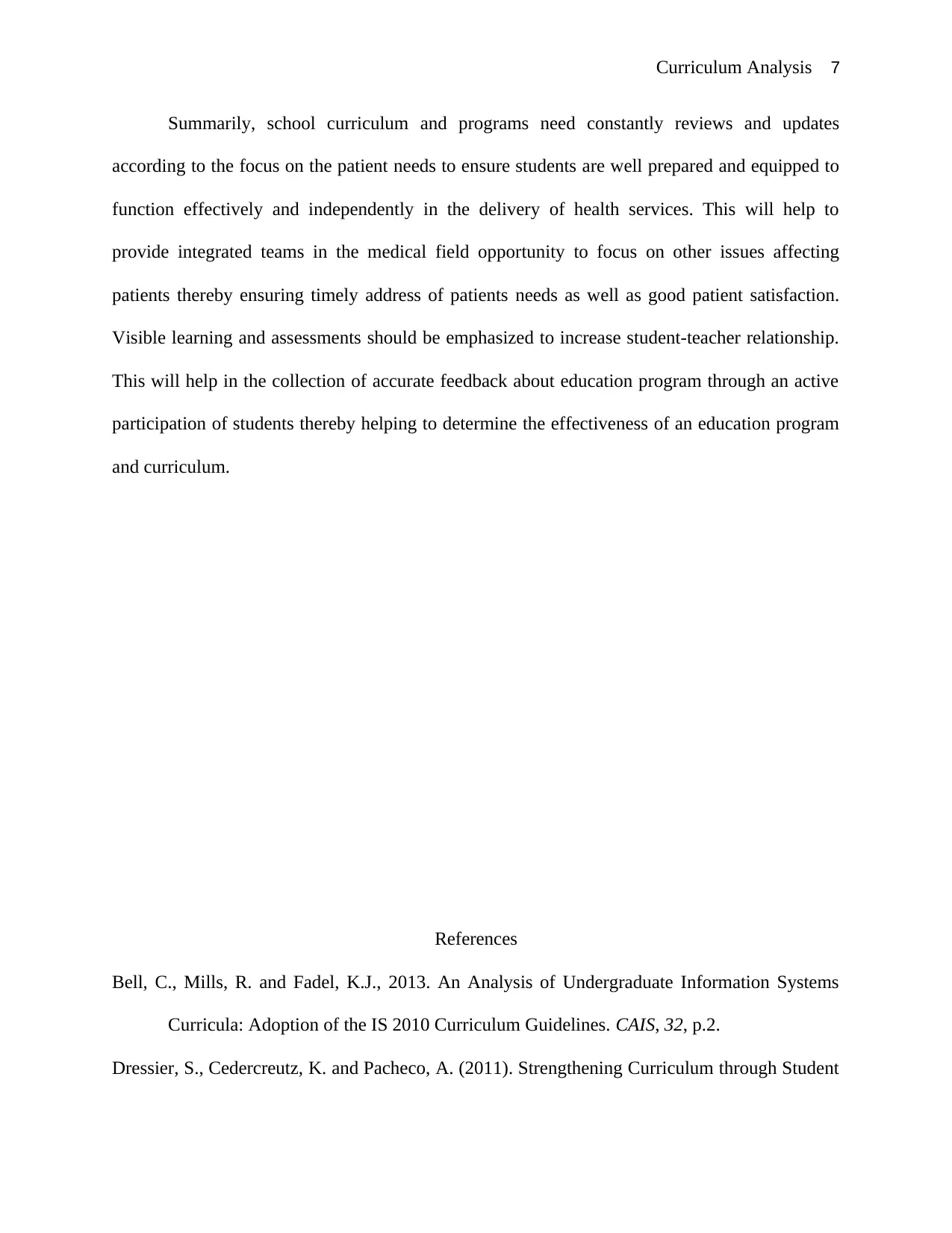
Curriculum Analysis 7
Summarily, school curriculum and programs need constantly reviews and updates
according to the focus on the patient needs to ensure students are well prepared and equipped to
function effectively and independently in the delivery of health services. This will help to
provide integrated teams in the medical field opportunity to focus on other issues affecting
patients thereby ensuring timely address of patients needs as well as good patient satisfaction.
Visible learning and assessments should be emphasized to increase student-teacher relationship.
This will help in the collection of accurate feedback about education program through an active
participation of students thereby helping to determine the effectiveness of an education program
and curriculum.
References
Bell, C., Mills, R. and Fadel, K.J., 2013. An Analysis of Undergraduate Information Systems
Curricula: Adoption of the IS 2010 Curriculum Guidelines. CAIS, 32, p.2.
Dressier, S., Cedercreutz, K. and Pacheco, A. (2011). Strengthening Curriculum through Student
Summarily, school curriculum and programs need constantly reviews and updates
according to the focus on the patient needs to ensure students are well prepared and equipped to
function effectively and independently in the delivery of health services. This will help to
provide integrated teams in the medical field opportunity to focus on other issues affecting
patients thereby ensuring timely address of patients needs as well as good patient satisfaction.
Visible learning and assessments should be emphasized to increase student-teacher relationship.
This will help in the collection of accurate feedback about education program through an active
participation of students thereby helping to determine the effectiveness of an education program
and curriculum.
References
Bell, C., Mills, R. and Fadel, K.J., 2013. An Analysis of Undergraduate Information Systems
Curricula: Adoption of the IS 2010 Curriculum Guidelines. CAIS, 32, p.2.
Dressier, S., Cedercreutz, K. and Pacheco, A. (2011). Strengthening Curriculum through Student
Paraphrase This Document
Need a fresh take? Get an instant paraphrase of this document with our AI Paraphraser
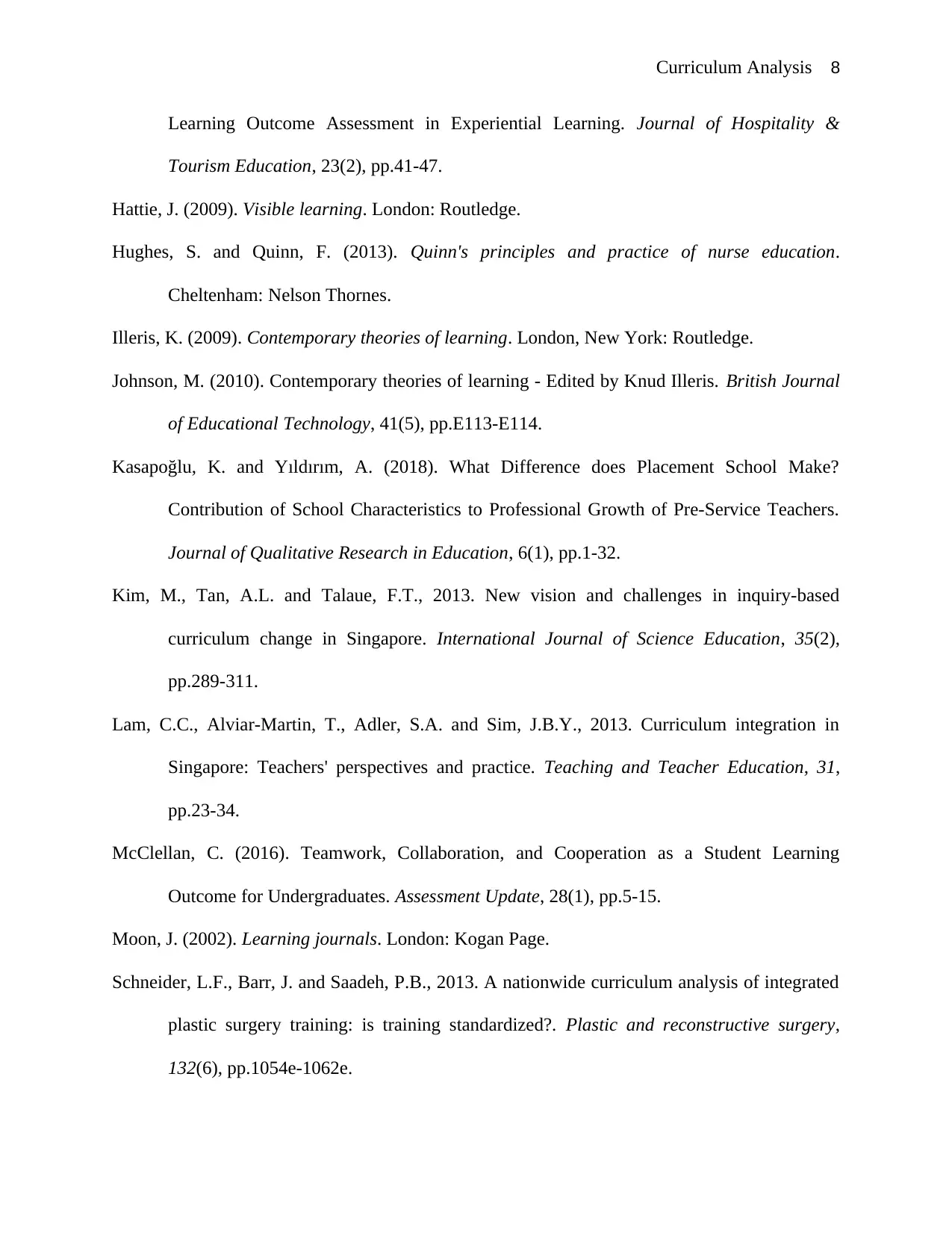
Curriculum Analysis 8
Learning Outcome Assessment in Experiential Learning. Journal of Hospitality &
Tourism Education, 23(2), pp.41-47.
Hattie, J. (2009). Visible learning. London: Routledge.
Hughes, S. and Quinn, F. (2013). Quinn's principles and practice of nurse education.
Cheltenham: Nelson Thornes.
Illeris, K. (2009). Contemporary theories of learning. London, New York: Routledge.
Johnson, M. (2010). Contemporary theories of learning - Edited by Knud Illeris. British Journal
of Educational Technology, 41(5), pp.E113-E114.
Kasapoğlu, K. and Yıldırım, A. (2018). What Difference does Placement School Make?
Contribution of School Characteristics to Professional Growth of Pre-Service Teachers.
Journal of Qualitative Research in Education, 6(1), pp.1-32.
Kim, M., Tan, A.L. and Talaue, F.T., 2013. New vision and challenges in inquiry-based
curriculum change in Singapore. International Journal of Science Education, 35(2),
pp.289-311.
Lam, C.C., Alviar-Martin, T., Adler, S.A. and Sim, J.B.Y., 2013. Curriculum integration in
Singapore: Teachers' perspectives and practice. Teaching and Teacher Education, 31,
pp.23-34.
McClellan, C. (2016). Teamwork, Collaboration, and Cooperation as a Student Learning
Outcome for Undergraduates. Assessment Update, 28(1), pp.5-15.
Moon, J. (2002). Learning journals. London: Kogan Page.
Schneider, L.F., Barr, J. and Saadeh, P.B., 2013. A nationwide curriculum analysis of integrated
plastic surgery training: is training standardized?. Plastic and reconstructive surgery,
132(6), pp.1054e-1062e.
Learning Outcome Assessment in Experiential Learning. Journal of Hospitality &
Tourism Education, 23(2), pp.41-47.
Hattie, J. (2009). Visible learning. London: Routledge.
Hughes, S. and Quinn, F. (2013). Quinn's principles and practice of nurse education.
Cheltenham: Nelson Thornes.
Illeris, K. (2009). Contemporary theories of learning. London, New York: Routledge.
Johnson, M. (2010). Contemporary theories of learning - Edited by Knud Illeris. British Journal
of Educational Technology, 41(5), pp.E113-E114.
Kasapoğlu, K. and Yıldırım, A. (2018). What Difference does Placement School Make?
Contribution of School Characteristics to Professional Growth of Pre-Service Teachers.
Journal of Qualitative Research in Education, 6(1), pp.1-32.
Kim, M., Tan, A.L. and Talaue, F.T., 2013. New vision and challenges in inquiry-based
curriculum change in Singapore. International Journal of Science Education, 35(2),
pp.289-311.
Lam, C.C., Alviar-Martin, T., Adler, S.A. and Sim, J.B.Y., 2013. Curriculum integration in
Singapore: Teachers' perspectives and practice. Teaching and Teacher Education, 31,
pp.23-34.
McClellan, C. (2016). Teamwork, Collaboration, and Cooperation as a Student Learning
Outcome for Undergraduates. Assessment Update, 28(1), pp.5-15.
Moon, J. (2002). Learning journals. London: Kogan Page.
Schneider, L.F., Barr, J. and Saadeh, P.B., 2013. A nationwide curriculum analysis of integrated
plastic surgery training: is training standardized?. Plastic and reconstructive surgery,
132(6), pp.1054e-1062e.
1 out of 8
Related Documents
Your All-in-One AI-Powered Toolkit for Academic Success.
+13062052269
info@desklib.com
Available 24*7 on WhatsApp / Email
![[object Object]](/_next/static/media/star-bottom.7253800d.svg)
Unlock your academic potential
Copyright © 2020–2026 A2Z Services. All Rights Reserved. Developed and managed by ZUCOL.





